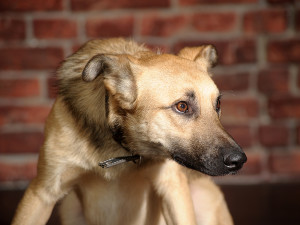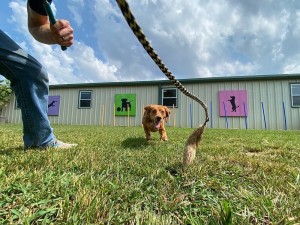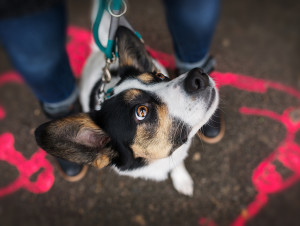How to Recognize the Signs of Dog Aggression
A PSA to pay better attention to our best friends’ body language.

Share Article
You know when your dog is happy or playful, when they desperately want a bite of your snack or a leisurely walk around the neighborhood. You know their expressions and their moods and could easily pick your pup out of a lineup of similar-looking dogs. You may even pride yourself on knowing your dog better than you know anyone else. And if you wake up every day thinking that your human friends might be mad at you for some reason (as many millennials do), at least you can always count on dogs to be on your side. Right? Right?
The reality is you may not know your dog quite as well as you think you do. A December 2022 studyopens in a new tab led by the DogStudies research group at the Max Planck Institute of Geoanthropology found that humans aren’t the best at recognizing aggression in dogsopens in a new tab — or even in other humans. This lack of recognition can lead to serious danger, especially when approaching a strange dog.

Get (totally free) deals for food, treats, accessories, tech, and way more pet parenting must-haves.
opens in a new tabKinship spoke to Dr. Juliane Bräuer, DogStudies Research Group Leader and senior author of the research article, to explore why you may be misinterpreting one of your dog’s biggest emotions.
The study explored humans’ ability to classify interactions and predict outcomes.
Researchers showed 92 participants videos of nonverbal interactions between pairs of humans, dogs, and primates. The participants were split into two groups, with one group categorizing the interactions in the 27 videos as playful, neutral, or aggressive, and the other group predicting the outcome of each social interaction.
The participants managed to predict accurate outcomes in 50 percent to 80 percent of the videos. But their ability to identify behaviors and predict what would happen next largely depended on whether the participants were viewing a video of primates, dogs, or humans. In fact, to the researchers’ surprise, participants in the study performed especially poorly when it came to recognizing aggressive interactions in both dogs and their fellow humans.
Dr. Bräuer notes, however, that the results of the study are a bit more complicated than they appear at first glance. While participants may have struggled with categorizing the video interactions, they were much better at predicting emotions, which is more crucial in an evolutionary sense than simply identifying emotions.
Recognizing aggression is not humans’ strong suit.
The experimenters involved in the study expected their subjects to have no problem recognizing aggression in dogs. After all, dogs are known as man’s best friend for a reason, and our long history of interacting with canines should suggest that we are able to read their emotions and body language fairly well.
But on this count, researchers were proven wrong. In fact, participants performed especially poorly when it came to spotting aggressive interactions, regardless of whether they were dog parents or not. In past similar studies, Dr. Bräuer says, researchers have found that dog parents have no advantage over non-parents when it comes to recognizing aggression.
“We know that dogs are very good at reading humans,” Dr. Bräuer says, noting that this is a skill that dogs have developed over time throughout their evolution from wolves. “But we’re not only bad at recognizing aggression; we’re also bad at predicting what’s happening in a playful interaction, where it’s not so clear. For example, maybe one of the dogs didn’t mean to be aggressive, but the other dog perceived it that way.”
Thankfully, we’re not too shabby when it comes to understanding dogs’ more obviously playful intentions with each other and can generally tell play-fighting from the real deal. So, when you see your pup make a new friendopens in a new tab at the dog park, you’re probably easily able to tell if things are going well. However, humans tend to underestimate aggression in dogs, unless the emotion is severe, such as when a dog is snarling or offering warning growlsopens in a new tab.
Our love for our pups (and all dogs) may cause bias.
Researchers theorize that one reason we may struggle to recognize aggression is simply because we love dogs and assume the best of any canine we see, regardless of what their expressions and body language may tell us.
“We have this picture that we are nice humans, and these are nice, cute, little dogs,” Dr. Bräuer says. “We expect the best of both dogs and humans.”
If you’re like most pet parents, you’re constantly snapping photos of your precious pup and speaking to them in a baby voice that would embarrass you if anyone heard it. So, maybe it’s no surprise that our love for dogs could keep us from realizing when they’re truly angry.
Dogs express aggression in a variety of ways, including growling, barking, and snarling, and sometimes even their play with other dogs can seem violent. But playful dogs tend to avoid biting down on their playmates or even roll over on their backs or let themselves be caught during an intense chase. Genuinely aggressive dogs, however, show no signs of backing down, and their bite is often much worse than their bark.
We’re Also Not Great at Reading Human Aggression
Maybe the most surprising part of the study is the revelation that humans aren’t even skilled in recognizing aggression in each other. Just as bias may blind us to the genuine feelings of canines, we may automatically assume the best of our fellow man as well. So, unless someone is obviously angry with you (we’re talking screaming and cursing), you may miss the signs of aggression even in people around you.
“With severe aggression, no matter the species, we’re good at recognizing it,” Dr. Bräuer says. “When it’s more subtle, then it starts to be more difficult.”
No matter how much you love your dog or dogs in general (it’s probably a lot), it’s important to understand how they communicateopens in a new tab so you can better meet their needs and speak in their language. Love can certainly bridge the divide between you and your dog, but it never hurts to learn a little more about your four-legged best friend — which will only help you translate that love into body language (and plenty of pets and kisses).

Savannah Admire
Savannah Admire is a writer, poet, and pet mom to three dogs and a cat. She currently lives in Western Maryland. When she’s not writing, you can find her reading, taking photos, or volunteering as a content creator for her local community theatre. Her debut poetry book, Mother Viper, is due out August 12, 2025, and you can follow her on Instagram at @savannahcooperpoetopens in a new tab.
Related articles
![Jack Russell puppy grunting while laying on blanket and crying out]() opens in a new tab
opens in a new tabListen Up! Your Puppy Is Trying to Talk to You
How to make sense of all those grunts and whines.
![Brown, half breed dog sitting on a chair next to his owner, a blonde stylish woman wearing a brown smart suit.]() opens in a new tab
opens in a new tabYour Dog Can Read Your Mind, Kind Of
Researchers say dogs actually have a pretty good sense of what we’re thinking.
![Golden Retrieve dog running in the grass outside, playfully chasing a flirt pole held by a man in blue jeans]() opens in a new tab
opens in a new tabYour Dog Is Bored. Here’s How to Solve That
Get out the toys and puzzles.
![Dog on leash sitting on a colorful street and looking attentive at their pet parent]() opens in a new tab
opens in a new tabHow to Get Your Dog to Pay Attention to You
Here are some simple steps to pry your pup away from that one spot in the yard they’re obsessed with.
![good dog owner plays with her husky in the grass]() opens in a new tab
opens in a new tabWhat Makes A Great Dog Person?
Good dogs deserve good dog people. Here’s how to be one.
![]() opens in a new tab
opens in a new tabAnimal Communicator Jessica Lanyadoo Is, in Fact, Not Doctor Doolittle
But she can talk to your pets. Btw, she says your dog says “hi”...and to clean their water bowl more.









